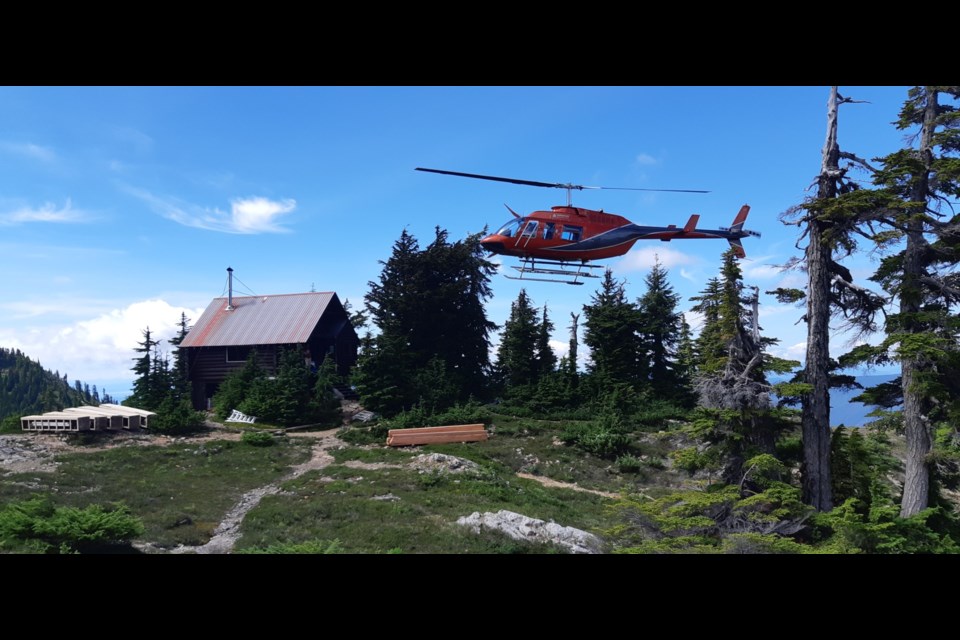It’s got a high-tech interior, historic siding and a view to kill for – at 5,000 feet, one of the Coast’s best.
Of course, it’s the Tetrahedron Provincial Park’s newest outhouse, built this summer on volunteer power along with the re-roofing and renovation of its accessory structure: the Mount Steele Cabin.
Tetrahedron Outdoor Club maintains the park’s four cabins and trail network. Three club members dropped by the Coast Reporter office last month to chat about a summer that saw more than 1,000 volunteer hours poured into the club’s highest-elevation cabin, among other park maintenance efforts.
“So many people in the community donated in-kind materials, money and labour,” said one of the club directors, Melissa Rayfield.
Aug. 12 to 19, dozens of volunteers, including teams from Tantalus Roofing and Strait Timber, replaced the Steele cabin’s roof (circa. 1989), the cabin stairs, fixed an errant wall and replaced the pit toilet (circa. 1987).
Conveyor toilet
In planning the “palatial” outhouse replacement, BC Parks (which club members credit with renewed collaboration and contributions of late) wanted a facility that was good for the environment and cut down on the need to helicopter out refuse, longtime club member George Smith said. The new outhouse is a conveyor toilet – where waste falls onto a conveyor, which separates liquids and solids, and then one pumps a pedal to move the solids into a holding pit, the cabin’s co-steward Bryce Rudland explained. The solids then decompose over a few years. (The club’s other cabins use honeypot outhouses, with waste containers helicoptered out when full.)
“Getting poo contained in the backcountry is a heroic effort,” said Rayfield.
“In a park!” added Smith.
Replacing the roof
Because of the park’s alpine fragility and the area being the watershed for most of the lower Sunshine Coast population, the cabins (built in 1987) are the only locations one is allowed to stay overnight in the park.
The Steele Cabin’s roof was a 1989 replacement for the original cedar shakes, which didn’t work at such elevations and were ripped off after two years in favour of a metal roof installed by volunteers in what Smith called his “most heroic building experience”, weathering snow, rain, sleet and hail over a long weekend. When ripped off in August, the old roof was weather-beaten from wind and ice, the exposed sections worn down.
COVID took a toll on the cabin too, as no one was visiting and heating it, the structure twisted and warped, said Rudland. Water would rush in from one of the walls, he said. And on the roof, they found cracks and missing screws.
While a crew of about seven camped at the cabin, the (volunteer) professional roofers were helicoptered in to replace the 45-degree angle roof, with the material taken off re-used to side the outhouse. Rudland credited his co-steward Alex Aegeter with much planning and volunteering for the project.
The volunteers also chinked the fir-log cabin and painted the structure. (Effective heat retention is essential as all of the firewood is flown in. Cabin fees at $15 a night go a long way to keeping the firewood stoked, explained the club members).
The project took 36 helicopter loads of supplies, including 93 bags of concrete, a cement mixer, wood, roofing materials, a generator, the paint, the people (and a little bit of beer).
The project almost didn’t get off the ground as the Airspan Helicopters Ltd. helicopter the club had planned to use (with a 1,600 lb lift) was called out to fight fires in B.C.'s Interior, so the club had use of a smaller aircraft with a 700 lb limit, doubling the required trips. But Aegeter rejigged the plan to make the new arrangement work.
The Sunshine Coast Natural History Society also donated some money for helicopters and some of its members were flown up when the roofers were flown out to do a bio blitz, enumerating the species of the area. The society is installing new educational signage on some of the trails at the peak.
While in the past the club has reached out to the community to ramp up support and volunteer participation, this time they’re reaching out in thanks, said Rayfield, stressing how much labour, money and equipment was donated.
“I think the cabins are better off now than when we built them,” said Smith.
Stewards
“We always need more awareness about what's going on up there,” said Smith.
“Most people don't go north of the highway,” he said. “We live in one of the most amazing places in the world and we wanted people to know about it. It's one of the oldest forests in Canada.”
“We've been taking people up there for years and years and years and when you watch the reaction, kids and people who just live here but have never experienced it, it's just wonderful.”
Bridge replacements, trail maintenance, cabin maintenance, the summer is busy for club volunteers, and they’re always recruiting. “Summertime in the Tetrahedron is when all the work happens,” says Melissa, “and winter is when we play.”
For more information about the Tetrahedron Outdoor Club, visit www.tetoutdoor.ca.
Correction: While George Smith initiated the cabins and trails project for the Tetrahedron cabins, he is not a founding member of the Tetrahedron Outdoor Club. We regret the error.




